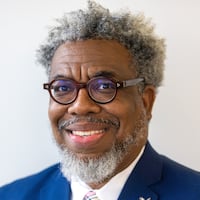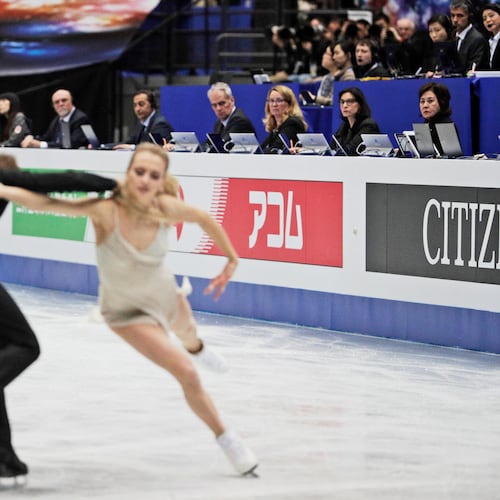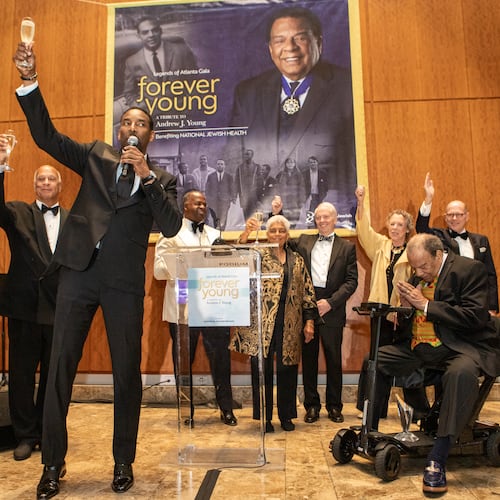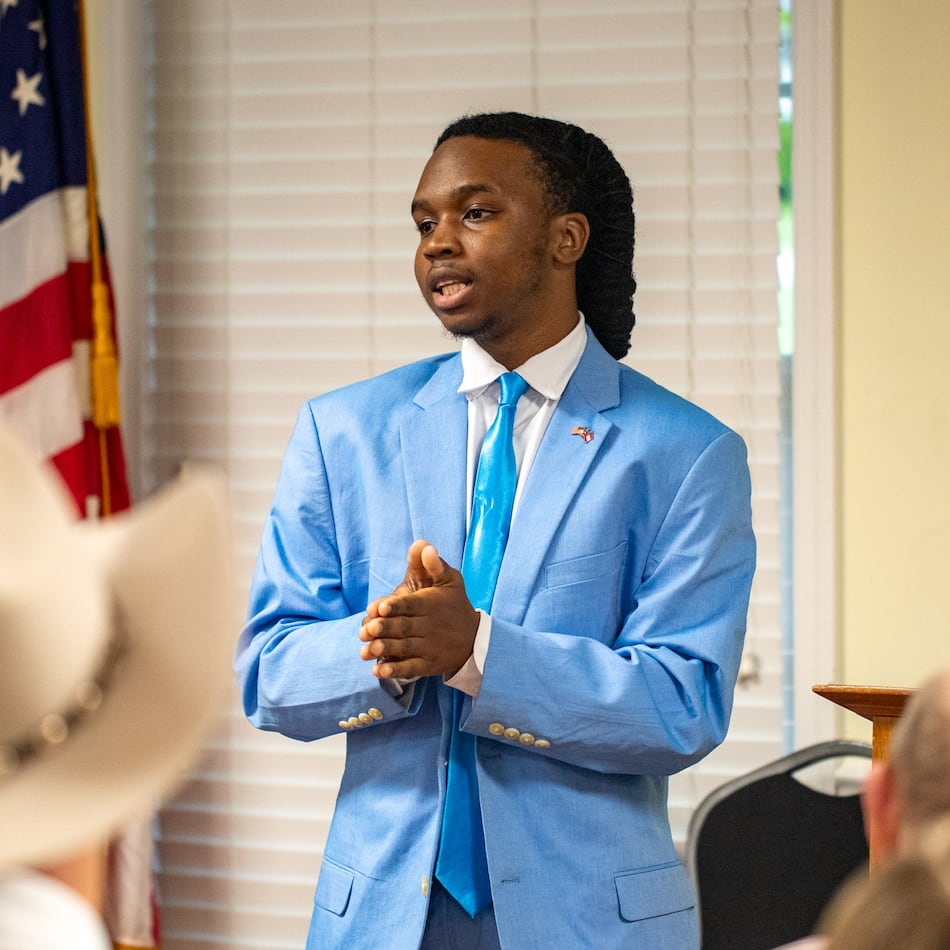In the new documentary tracing the life of three-time Olympian Edwin Moses, a couple questions hover over the sprawling piece.
Is he one of the greatest track figures ever who happens to be a nerd?
Or is he the biggest nerd who also happens to be a great track athlete?
“I was a student-athlete in every sense of the word because physics was very unforgiving. There were no breaks for us,” said the 1978 graduate of Morehouse College. “I was a serious nerd. I was the guy with the slide rule. Track and field was my hobby.”
Credit: Johannes Imdahl
Credit: Johannes Imdahl
While using that slide rule at Morehouse, Moses was also becoming history’s most dominant 400-meter hurdler, racing to two Olympic gold medals, a world championship and breaking several records in a decade-long winning streak.
Moses will return to Morehouse on Sept. 21 for the world premiere of “MOSES — 13 Steps,” a documentary about his life on and off the track. The film, directed by Michael Wech and executive produced by Broadview Pictures and Morgan Freeman’s Revelations Entertainment, will close out the sixth annual Morehouse College Human Rights Film Festival.
The title of the film refers to how many steps Moses ran between hurdles.
Credit: Moses - 13 Steps
Credit: Moses - 13 Steps
“On the track, no one could match him for a decade,” said Freeman, who asked Moses in 2005 why there wasn’t a film about his life. “Off the track, he left an even greater legacy.”
Using rare archival footage, the film explores Moses’ roots as a physics major at Morehouse and how he outthought his opponents by using science and math to perfect his hurdling skills.
The film also charts how Moses fought for better pay and appearance fees for athletes, and examines his work with the U.S. Anti-Doping Agency to clean up sports.
“I have been biting at the bit for people to see the film,” Moses said. “My mom told me that it may take years for people to understand the scope of my accomplishments on the track. She never felt that I got a lot of justice and told me to save everything because ‘You don’t want to leave this world without leaving your story behind.’”
Moses is joined in the film by fellow Morehouse graduates Samuel L. Jackson and Spike Lee, who breathlessly recounts watching Moses compete in the 1976 Olympics, while playfully recalling how nobody on campus would have expected it from the bookish physics major with thick glasses.
“With his glasses, if you didn’t see him run …,” Lee said. “I’m not gonna lie. I saw him run, but he might have been the only person who believed he could do that.”
Credit: Johannes Imdahl
Credit: Johannes Imdahl
While Olympic champs Tommie Smith, Daley Thompson and Donna de Varona appear in the film, it also includes astrophysicist Neil deGrasse Tyson and historian Lonnie Bunch, secretary of the Smithsonian Institution.
Moses was born into a middle-class family in Dayton, Ohio, surrounded by doctors and lawyers inside his neighborhood and crime outside, which he navigated through to attend school.
His parents graduated from Kentucky State University and his father, Irving Moses Sr., a Tuskegee Airman, became an elementary school principal when he couldn’t get into medical school.
Irving Moses made sure all of his boys, Irving Jr., Edwin and Vincent, dressed neatly and kept their shoes shined.
“That was discipline. My dad was a good man, but we all knew growing up that there was a solid line around us that we couldn’t cross,” Moses said. “That applied to academics, the way we treated people, our social demeanor and activities we were involved with. I am so glad that I grew up like that.”
Credit: Martin Christ
Credit: Martin Christ
Bypassing larger schools, Moses entered Morehouse in 1973 on an academic scholarship. Although he made the track team as a walk-on, Moses never technically ran on campus since Morehouse didn’t have a track.
Instead, he and his teammates trained at local high schools, sometimes sneaking onto neighboring college tracks to practice and also experiment.
In grueling 400-meter hurdles, which combine speed with stamina and grace, Moses developed a technique where he took 13 steps between hurdles, while most of his rivals were taking 15 steps.
Credit: LENNOX MCLENDON
Credit: LENNOX MCLENDON
Moses, who always came out of the starting blocks hard because he saw himself as a pure quarter-miler, discovered he could shave valuable seconds off his times by lengthening his stride and learning to jump off his left foot.
“The 13-step pattern in the 400-meter hurdles is extremely difficult,” said track and field coach Bob Kersee. “It takes the endurance from hurdle number seven on. So to keep that stride pattern going, in fatigue, while you hurting … To literally see him change the sport in a year was a beautiful thing to see.”
In explaining the math behind 13 steps, Moses sounds like a college professor lecturing students about distances, resistance, map patterns and radius. He even details how the specific area within his running lane helped him navigate left-hand turns and jumps.
Credit: Johannes Imdahl
Credit: Johannes Imdahl
“For most races, I ran 151, 152 or 153 steps,” Moses said, pulling out old notebooks of handwritten training logs that detail not only every race he’s run but the science behind his training.
“When I tell people I have run 27,000 miles, I have run 27,000 miles because I’ve logged it.”
In 1976, while still a student at Morehouse, he made the United States Olympic Team, winning his first Olympic gold medal in the 400-meter hurdles in Montreal. Moses didn’t compete in the 1980 Olympics because of the boycott of the 1980 Games in Moscow, ordered by then-President Jimmy Carter.
“We got robbed in 1980,” said Moses, who three weeks before the 1980 Olympics beat the eventual gold medalist in a race by nearly two seconds. “I have friends who qualified for the team in 1980 who still have PTSD. You never get over that.”
Moses would have to wait until 1984 in Los Angeles to win his second Olympic gold medal. “In my mind,” Moses said in the film, “I could not lose.”
With that came more numbers.
Credit: MOSES - 13 Steps
Credit: MOSES - 13 Steps
Between 1977 and 1987 — nine years, nine months and nine days — Moses won 122 races in a row. To understand how dominant Moses’ streak was, 400-meter sprinter Michael Johnson, who shined in the 1996 Olympic Games in Atlanta, summed it up quickly.
“I won 58 races in a row,” Johnson said. “And I’m second.”
The Morehouse College Human Rights Film Festival runs from Sept. 17-24 and will feature nearly 40 films focusing on the principles of equality and social justice.
The screening of “MOSES — 13 Steps” will begin at 7 p.m. on Saturday, at the Rev. Martin Luther King Jr. International Chapel on the Morehouse campus.
Moses will speak at the event, after being presented with the inaugural Dr. Edwin C. Moses Humanitarian Award, recognizing how his contributions on and off the track have inspired generations to overcome barriers, and drive social and scientific change.
“MOSES — 13 Steps,” will also receive the festival’s Enlightened Lens — Documentary Feature Award.
“Edwin has been a wonderful pillar of advocacy for the Morehouse community,” said Kara Walker, executive director of the festival.
“His global impact deserves a grand stage, and we are deeply honored that he chose to come back home to our campus and festival for the premiere of his life’s story and work.”
Sign up for the UATL newsletter.
Read more stories like this by liking UATL on Facebook and following @itsUATL on X and Instagram.
About the Author
Keep Reading
The Latest
Featured











